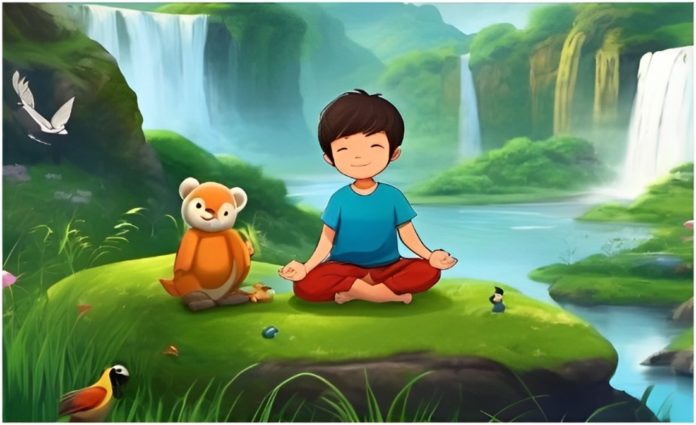In our fast-paced world, stress is almost unavoidable. However, meditation have a simple and effective way to find calm amidst the chaos. Just a few minutes of meditation daily can significantly improve your mental health as well as physical well-being.
Why should you Choose Meditation?
Meditation has been practiced for thousands of years. Originally, it was used to deepen understanding of sacred and mystical forces. Today, it’s mainly used to reduce stress and enhance relaxation. You can meditate anywhere, whether you’re commuting, waiting for an appointment, vacation, tour, classroom, office or even during a hectic workday.

What is Meditation?
Meditation is a mind-body practice that focuses your attention and eliminates the stream of thoughts which causing stress. This focused state can lead to significant physical and emotional benefits.
Meditation Benefits
- Emotional Balance: Regular meditation helps create a sense of calm and emotional stability. Medittion also helps to take the right descision to right time and place.
- Stress Reduction: By focusing on calming elements, meditation helps to manage and relief your stress. Meditation reduces your stress level almost by 50-70 Percentage, which is also depend on your stress type.
- Self-Awareness: Meditation increases mindfulness, helping you become more aware of the present moment. If you could aware of anything, the risk of being bad is automatically reduced.
- Physical Health: Benefits include lower blood pressure, reduced heart rate, making good posture, Flexible body and improved sleep quality.
Meditation and Health Conditions
Many Research suggests that meditation can help manage symptoms of various conditions, especially those worsened by stress. Many people are doing meditation for anxeity, depression and reducing others risks. These include:
- Anxiety
- Asthma
- Chronic pain
- Depression
- Heart disease
- Sleep disorders
- High Blood Pressure
While meditation complements medical treatments, it is not a substitute. Always consult your healthcare provider before starting any new treatment.

Types of Meditation
There are various types of meditation, each with unique techniques but a common goal: inner peace. Here are some popular forms:
- Guided Meditation: Involves visualizing calming scenes, often led by an instructor.
- Mantra Meditation: We could do it by involves silently repeating a word, phrase, or sound to avoid distracting thoughts. Chanting “OM” would be the best one as per my views.
- Mindfulness Meditation: You can focuses on being present and aware of your breath and body.
- Qigong and Tai Chi: Combine movement, breath control, and meditate to restore balance.
- Yoga: Uses postures and controlled breathing to enhance flexibility and mental clarity.
Things you should remember when Meditating
To get the best meditation, you should include the following elements:
- Focused Attention: Concentrate on a single object, mantra, or your breathing. Chanting any Mantras, or simpley repeating “OM” would be better. Or you can even chant the goddess in which, you believe.

- Relaxed Breathing: Practice deep breathing, even-paced breathing to calm your mind. Every beginner should enter with practicing with this breathing technique.
- Quiet Setting: Minimize distractions, especially if you’re new to meditation. We are habitated to give the full attention, for those, which is unnessery. If you are good at this, yuou can listen a single voice in a crowd. This techniques are most preferable for the students.
- Comfortable Position: Sit, lie down, or walk in a position that allows you to relax while staying alert. Many of the practitioner begin to medidate without caring the poster of the body, which causes more difficulties later.
- Open Attitude: Let thoughts come and go without judgment. Think about the Nature, Like River, Trees, Land etc. and think about the nature gave me many things, but what could i do for them?
Incorporating Meditation into Daily Life
It doesn’t require elaborate preparations. Here are some easy ways to add it to your routine:
- Deep Breathing: Focus on your breath, feeling each inhalation and exhalation.
- Mentally Body Scan: Mentally scan your body from head to toe. Also feels about the areas of tension and consciously relaxing them.
- Mindful Reading: Read inspiring texts or poems, reflecting on their meaning, or listen to soothing music.
- Loving-Kindness Meditation: This meditation involves thinking about others with loving, kind and compassionate feelings. It may enhance your sense of connection with others.
- Walking Meditation: Slow your pace and focus on each step, noticing the sensations in your feet and the environment around you.
(Whenever you apply this technique, lower but maintain walking speed in such a way the attention of each movement of your legs or feet is gotten. Avoid looking at where you are heading to. Let all your concentration be on the legs and feet.
As you pick up the foot, carry the leg forward and position the foot on the surface, echo these action verbs in your mind “lifting,” “moving” and “placing.” Pay attention to the things you can see, hear as well as those you can smell around you.)
Why don’t i like to meditate continuously? Solution:
1. Lack of Time: Too many a person’s thinking time is never enough to meditate, however, it is possible to experience significant change by taking only a few minutes daily. Commence with only five to ten minutes of meditation every day then slowly increase on how long it takes with time for you to be at ease.
2. Difficulty Concentrating; Often, individuals encounter difficulty in focusing when involved in the meditation process. One simple way to get into the mood for it is by following some guided meditations that give hints on what to do next. In the long run, your concentration level will increase.
3. Misunderstanding Meditation: There are misconceptions about meditation being a religious practice or requiring special skills. Meditation is a universal things for relaxation and stress reduction, which is open to anyone regardless of their background.
4. Discomfort with Stillness Sitting still and being quiet can be uncomfortable for some. If this resonates with you, consider active forms of meditation like walking, yoga, or tai chi, which combine movement with mindfulness.
5. Fear of Failure: Fears, which doesn’t allowed you to doing meditation “correctly.” Remember, there is no perfect way to meditate. The key is to find a method that works for you and to practice without self-judgment.
Also Read: Learn to Calculate Time for Proper Sleep
6. Restlessness Firstly, the restlessness can make it challenging to sit through a meditation session. Start with shorter sessions and incorporate techniques like deep breathing or progressive muscle relaxation to ease into longer periods of stillness.
7. Expectations of Immediate Results People may expect immediate benefits from meditation and feel discouraged when they don’t see them. Meditation requires patience and consistent practice. Over time, you’ll notice improvements in your mental and physical well-being.
8. Lack of Guidance Without proper guidance, it can be hard to know where to begin. Use apps, online resources, or join a local meditation group to receive instruction and support from experienced practitioners.
9. Physical Discomfort Sitting for extended periods can cause physical discomfort. Find a comfortable position, whether it’s sitting on a cushion, in a chair, or even lying down. Ensure your posture supports relaxation without straining your body.
10. Perceived Ineffectiveness Some doubt the effectiveness of meditation. Scientific research, however, supports its benefits, including reduced stress, improved concentration, and enhanced emotional health. Give meditation a fair chance, and you may be surprised by the results.
So now, you can also do meditation with easily and proper way. I would like to teach you the best and easy method/way to do meditate in any time. With following these steps, you can medidate yourself anywhere, anytime and in any condition.
Easy Meditation Tecchniques
- Take a easy and comfortable Seat: Find a spot that feels calm and peaceful to you. Sit down and get comfortable. At first, it is better if there are no any obstruction, like animals or human.

- Set a Time Limit: For beginners, it’s helpful to start with a short session. Aim for five or ten minutes to begin with. After you are in habbit of it you can even do it unlimitadely.
- Notice and feel your Body parts: Sit in a position that feels stable and that you can maintain for a while. This could be in a chair with your feet on the floor, cross-legged, or kneeling.
- Feel Your Breath: Pay attention to the sensation of your breath as it enters and leaves your body. Focus on this natural rhythm.
- Notice When Your Mind Wanders: It’s natural for your mind to stray. When you realize that your thoughts have drifted, gently bring your focus back to your breath.
- Be Kind to Your Wandering Mind: Avoid judging yourself for getting distracted. Simply return your attention to your breath without frustration.
- Close with Kindness: When you’re ready to finish, gently lift your gaze if your eyes are closed. Also take a moment to notice the sounds around you, the feeling in your body, and your current thoughts and emotions. Isn’t that easy.
If you have any questions, problems or curiosity about meditating, please feel free to message us via email or you can even comment down below. Thank you for reading this article carefully.

